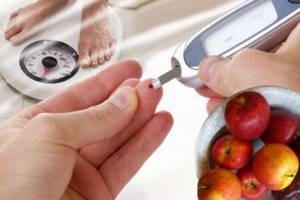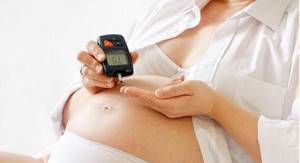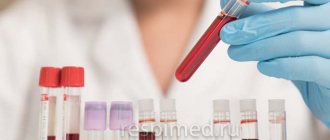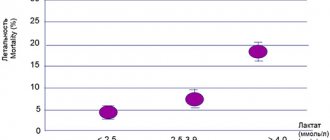Fluctuations in glucose levels
Hyperglycemia (increase)
The patient may have either a short-term increase in blood sugar concentration or a permanent one. Increased levels on an empty stomach - more than 5.5 mmol/l, after a meal - more than 7.8 mmol/l. Hyperglycemia is divided into 4 forms:
- chronic hyperglycemia. It can be mild (6–10 mmol/l), moderate (10–16 mmol/l) and severe (more than 16 mmol/l). Occurs exclusively in patients with diabetes. Due to poor pancreatic function, the body produces insufficient amounts of insulin. And also this pathology is transmitted hereditarily.
- nutritional hyperglycemia. After eating, blood glucose levels increase, especially in the first few hours. This form of hyperglycemia does not require treatment, because glucose levels return to normal on their own after a certain period of time.
- emotional hyperglycemia. This form occurs after a stressful condition. Having excited the nervous system, the body begins to produce thyroid hormones. With a high content of them in the blood, the body stops producing glycogenesis, but the production of gluconeogenesis and glycogenolysis increases. For these reasons, blood sugar increases.
- hormonal hyperglycemia. It appears due to a surge of certain hormones in the blood, such as glucocorticoids, glucagon, catecholamines and thyroid hormones.
Symptoms of hyperglycemia:
- frequent urination;
- itching of the skin;
- hunger;
- strong thirst;
- blurred vision;
- drowsiness, lethargy;
- nausea.
Treatment is prescribed only if the development of hyperglycemia is detected.
During hypoglycemia, a diabetic needs to have something sweet on hand, as sugar can drop sharply
Hypoglycemia (sharp decrease)
Indicators are less than 3.3 mmol/l.
Main causes:
Symptoms of type 2 diabetes in women
- incorrect insulin dose;
- untimely consumption of food (missing more than 6 hours);
- insufficient amount of carbohydrates in the diet;
- unplanned or intense physical activity;
- alcohol abuse;
- drug use;
- non-compliance with the diet or an incorrectly formulated diet.
Symptoms of hypoglycemia:
- shiver;
- increased sweating;
- state of pathological fear;
- dizziness, fainting;
- hunger;
- increased heart rate;
- weakened vision;
- weakness, drowsiness, apathy;
- headache;
- increased irritability.
If there is a sudden decrease in blood glucose, the patient needs to eat something sweet, such as candy, honey, or drink tea with sugar.
IMPORTANT! In both cases, it is necessary to bring blood sugar to a normal level, since jumps in both directions lead to disturbances in the body’s metabolism.
The level of glucose in the blood directly depends on the age of the woman. Statistics show that deviations from the norm in most cases are observed in women after 40 years of age.
Blood test for sugar: norms
If the patient has the above symptoms, the doctor gives a referral for a blood sugar test. The norm when taken from a finger on an empty stomach is from 3.3 to 5.5 mmol/l, and after eating - 5.6-6.6 mmol/l. If the second indicator is reached when donating biomaterial on an empty stomach, then insulin sensitivity is impaired.
A reading of 6.7 mmol/l after analysis on an empty stomach indicates hyperglycemia - high blood sugar. If the symptom manifests itself chronically, then there is a high probability that the patient has diabetes. Hyperglycemia may be a sign of:
- endocrine diseases;
- disorders of the liver and hypothalamus;
- development of inflammatory processes.
A level below 3.3 mmol/l, on the contrary, is a signal of the development of hypoglycemia - a decrease in glucose levels, which can lead to seizures, headaches, and disruption of the pancreas, liver, kidneys and adrenal glands.
A blood sugar test helps detect existing pathologies.
Table of norms for glucose levels in women
| Age | Normal (µmol/l) |
| Up to 14 years old | From 2.8 to 5.6 |
| From 14 to 60 years | From 4.1 to 5.9 |
| From 60 to 90 years | From 4.6 to 6.4 |
| 90 and older | From 4.2 to 6.7 |
Normalizing weight and properly balanced nutrition is the key to success in the fight against diabetes.
If the level of dextrose concentration in the blood approaches 6.7 mmol/l, this means that diabetes mellitus may begin to develop, and blood should be taken again to clarify the result. Having studied glucose tolerance, specialists examine the level of glycosylated hemoglobin. Based on the results, a diagnosis of diabetes is made and treatment or diet is prescribed depending on the degree of its development.
You can measure your current blood sugar level by taking tests at a clinic or using a glucometer at home (if you know your blood glucose level). Test results will vary depending on the person's age, time since last meal, and test method. The normal level of sugar in venous blood will differ slightly from blood taken from a finger prick.
Indications
A referral for analysis can be issued by an endocrinologist, nephrologist, gastroenterologist, pediatrician, surgeon, or therapist.
A glucose tolerance test is prescribed in the following cases:
- glucosuria (increased sugar levels in the urine) in the absence of symptoms of diabetes mellitus and normal blood glucose levels;
- clinical symptoms of diabetes, but blood and urine sugar levels are normal;
- examination of patients with risk factors for diabetes: age over 45 years,
- body mass index BMI more than 25 kg/m2,
- arterial hypertension,
- lipid metabolism disorder;
- thyrotoxicosis (increased secretion of thyroid hormones from the thyroid gland);
GTT is also performed in patients with sensory neuropathy in conjunction with a vitamin B12 test to differentiate between diabetic neuropathy and other types of neuropathies.
Note: the level of C-peptide is of great importance, which allows you to assess the degree of functioning of cells that secrete insulin (islets of Langerhans). Thanks to this indicator, the type of diabetes mellitus (insulin-dependent or independent) and, accordingly, the type of therapy used are determined.
An oral glucose tolerance test allows you to diagnose various disorders of carbohydrate metabolism, such as diabetes mellitus, impaired glucose tolerance, fasting glycemia, but cannot clarify the type and causes of diabetes mellitus, and therefore, after receiving any result, it is advisable to conduct an additional examination:
- C-peptide,
- serum insulin,
- glycosylated hemoglobin.
When is it worth performing GTT?
| Age | Health status | Periodicity |
| over 45 years old |
|
|
| over 16 years old |
|
|
How to calculate BMI
BMI=(weight, kg) : (height, m)2
Cases when a glucose tolerance test is not performed
GTT is not advisable to carry out in the following cases
- recent heart attack or stroke;
- recent (less than 3 months) surgery;
- end of the 3rd trimester in pregnant women (preparation for childbirth), childbirth and the first time after it;
- preliminary blood biochemistry showed a sugar content of more than 7.0 mmol/l.
- against the background of any acute disease, including infectious.
- while taking medications that increase glycemic levels (glucocorticoids, thyroid hormones, thiazides, beta blockers, oral contraceptives).
Measuring sugar levels with a glucometer
This method is the fastest and most convenient. For more accurate indicators, the following tips should be followed:
- Read the instructions carefully.
- It is recommended to perform a blood test on an empty stomach (on an empty stomach).
- Wash your hands with soap and rub your finger to warm it up.
- Wipe your finger with an alcohol solution.
- Prick your finger on the side with a piercing pen.
- Take a second drop of blood onto the test strip: the first is removed with cotton wool.
- After two seconds, the test result will appear on the meter screen.

To ensure accurate results, follow the specialist’s recommendations before taking the test.
Rules for preparing for analysis
Preparation for analysis is very important. Consumption of food or liquid entails a change in the concentration of glucose in the blood, making the analysis inaccurate. Therefore, when donating blood from a vein or finger, it is recommended to limit the consumption of foods and liquids at least 8 hours before the test. An hour after a meal, the glucose concentration reaches 10 mmol/l. After two hours, the value drops to 8 mmol/l.
If you consumed mainly high-carbohydrate foods at your last meal before the test, you should wait at least 14 hours before taking blood for a more accurate result.
In addition to food, there are other factors that influence the final result of the analysis:
- physical exercise;
- stressful state;
- infectious diseases;
- fatigue (insufficient rest).
Before taking the test, the patient needs calm and rest. Therefore, the day before the test, it is recommended to protect yourself from physical activity, emotional turmoil and other factors that can change the condition of your body. If you do not follow medical instructions, the test result will be blurred and the condition of prediabetes will not be accurately detected.
A healthy person needs to donate blood for sugar once a year; for a diabetic, measuring the level of glucose concentration in the blood reaches 5 times a day. In insulin-dependent diabetes mellitus, it is necessary to measure your sugar level before each insulin injection. And it is also recommended to measure your glucose levels before bedtime and after sleep, as well as 60 minutes after meals.

Doctors recommend taking a glycemic index test for prevention purposes at least once every six months or year. This is especially true for women approaching 40 years of age and older.
Preparing for the glucose tolerance test
- For 3 days before the test, the patient must adhere to a normal diet without limiting carbohydrates, eliminate factors that can cause dehydration (insufficient drinking regimen, increased physical activity, the presence of intestinal disorders);
- Before the test, an 8-14 hour overnight fast is required (the test is performed on an empty stomach);
- On the day of blood sampling, you can only drink plain water, exclude hot drinks, juices, energy drinks, herbal decoctions, etc.;
- Before the analysis (30-40 minutes before), it is not advisable to chew sugar-containing chewing gum, brush your teeth with toothpaste (replace with tooth powder) and smoke;
- On the eve of the test and on the day of the test, it is prohibited to take alcohol and drugs/hard drugs;
- Also, during the day you need to protect yourself from any physical and psycho-emotional stress.
Peculiarities
- All current or recently completed courses of treatment must be reported to the doctor in advance;
- The examination is not carried out during the acute period of infectious and inflammatory processes (a false positive result is possible);
- The analysis is not taken immediately after other studies and procedures (X-ray, CT, ultrasound, fluorography, physiotherapy, massage, rectal examination, etc.);
- The female menstrual cycle can affect sugar concentrations, especially if the patient has carbohydrate metabolism disorders.
Normal blood glucose levels in pregnant women
Pregnant women should pay special attention to their blood sugar levels because they often exceed the norm. This factor is due to the fact that the hormonal background of a pregnant woman undergoes changes due to the provision of all useful substances to the unborn child. If your blood glucose levels range from 3.7 to 6.3 micromoles per liter of blood, there is nothing to worry about. When blood sugar levels are more than 6.3 µmol/L, the risk of developing gestational diabetes mellitus increases significantly. Gestational diabetes usually goes away after childbirth if you strictly follow the diet prescribed by your doctor. An increased rate of glycated sugar in the blood of a late pregnant woman indicates that the fetal weight will be more than 4500 g and the child will have a tendency to develop diabetes mellitus.

Due to hormonal changes in the body, expectant mothers are susceptible to sudden hyperglycemic surges
Blood sugar
When we talk about blood sugar, we mean the level of glucose - the main source of energy that ensures the normal functioning of organs and muscles.
Glucose concentration deviates from the norm in the presence of certain hormones in the body. Insulin, which is produced in the pancreas, is responsible for the decrease. And an increase in glucose levels can be triggered by several active substances: glucagon, adrenaline, norepinephrine, cortisol and corticosterone.
Such deviations cause certain pathological conditions, which are discussed below.
Symptoms of high sugar
High blood sugar can be recognized by the following symptoms:
- thirst and dry mouth;
- constant feeling of hunger;
- slow healing of wounds.
The subsequent increase in sugar leads to hyperglycemic coma, ketoacidosis and hyperosmolar coma.
How is the level of glycated hemoglobin determined?
Determining glycated hemoglobin has a number of advantages:
- Held at any time of the day.
- No preliminary preparation is required before testing.
- The analysis results will not be distorted due to physical activity, drinking alcohol, stress, colds, or changes in diet.
- The result is more accurate, it is difficult to correct it several days before the analysis.
- Women's menstrual cycle and its stage will not affect the test results.
- The result will show fairly long-term fluctuations in blood sugar, rather than short-term (recent) ones.
- The test results are not affected by the patient's age or gender.
The range of acceptable indicators is from 4.5 to 6.5. This is considered the norm for glycated hemoglobin for men and women of any age. If the result is from 5.5 to 7, the attending physician diagnoses “prediabetes”. For preventive purposes, adjustments are made to the patient’s diet, as tolerance to sugar is reduced.

Don't forget to check your glucose levels before eating
Symptoms of diabetes in women
Oddly enough, women are more likely to suffer from this disease. The opinion that the female sex is more predisposed to eating sweets is erroneous. What is the real reason for the development of diabetes in women? The body of women is structured differently, the endocrine system is no exception; it experiences hormonal changes during a woman’s pregnancy or during menopause, hence disturbances in insulin production are observed.
The first prerequisites for diabetes mellitus in women are:
- Thirst due to dry mouth.
- Sudden weight gain.
- Sudden weight loss (for no reason).
- Frequent urination (especially at night).
- Decreased performance, rapid fatigue.
- Dryness and itching of the skin.
- The appearance of age spots on the body and face.
- Deterioration of vision.
- Memory problems.
- Changes in the menstrual cycle.








